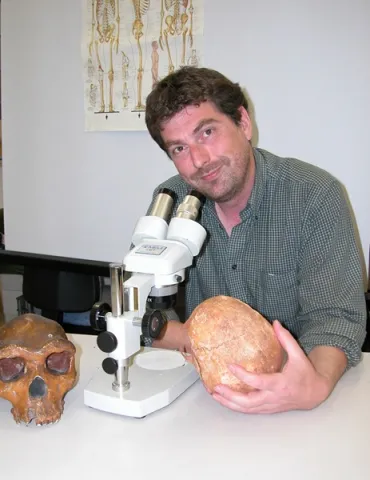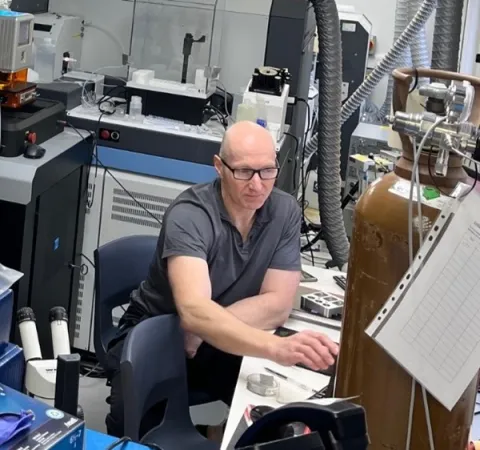Project overview
Art, whether figurative or non-figurative, is universally acknowledged by archaeologists and anthropologists to be a defining characteristic - perhaps the defining characteristic - of Homo sapiens, yet its origin and evolution remain very poorly understood.
European Upper Palaeolithic cave art provides the earliest respectable dataset in the Pleistocene artistic realm, and thus constitutes one of the very few sources of archaeological information about early human symbolic behaviour, the cognitive capacity, belief systems and aesthetic aptitudes of the earliest known artists.
European cave art has been assumed to be of Upper Palaeolithic age and, as such, its evolution has been integrated with that of the period’s chronocultural groupings and successions.
In recent years, its apparent abundance at certain times has been incorporated into models that propose cultural responses to climatic changes as a factor stimulating the evolution of symbolic behaviour(1). While its specific meaning will always remain hotly debated and probably remain unknown,
Palaeolithic cave art undoubtedly forms one of the most intimate windows into the archaeological past. Despite more than a century of study, however, chronological inaccuracy and imprecision severely hampers our understanding of nearly all aspects of cave art.
Furthermore, the relative academic isolation of cave art studies has been an obstacle to its understanding in the context of the broader archaeological record and thus from other aspects of the early behavioural development of Homo sapiens. Many key questions remain unanswered:
•When and why did cave art first appear?
•Why does it appear, on the basis of current evidence, earlier in Europe than Africa despite evidence for symbolic behaviour appearing first in Africa?
•Did cave art appear at the same time in France, Italy and the Iberian Peninsula?
•How does cave art relate to our well established chronologies for ‘below ground’ archaeology and the behavioural change this demonstrates?
•Given the growing evidence for symbolism among late Neanderthals, could it be that they were involved in the initial phases of the phenomenon, or was the appearance of cave art only related to the arrival of modern humans?
•If the former, was there a chronological gap, or overlap, between the two, i.e. was Neanderthal art and modern human art connected?
•If the latter, is its emergence contemporary with the initial dispersal/s of modern humans across Europe, or does it post-date their arrival?
•Are the assumptions underlying a 'stylistic chronology' for cave art justified, and can they be brought more into line with the evolution of material culture in Upper Palaeolithic Europe?
This proposal aims to advance our understanding of such questions by providing a reliable chronology for cave art using the newly developed method of U-Th dating of carbonate crusts that form on top of cave paintings.
European Upper Palaeolithic cave art provides the earliest respectable dataset in the Pleistocene artistic realm, and thus constitutes one of the very few sources of archaeological information about early human symbolic behaviour, the cognitive capacity, belief systems and aesthetic aptitudes of the earliest known artists.
European cave art has been assumed to be of Upper Palaeolithic age and, as such, its evolution has been integrated with that of the period’s chronocultural groupings and successions.
In recent years, its apparent abundance at certain times has been incorporated into models that propose cultural responses to climatic changes as a factor stimulating the evolution of symbolic behaviour(1). While its specific meaning will always remain hotly debated and probably remain unknown,
Palaeolithic cave art undoubtedly forms one of the most intimate windows into the archaeological past. Despite more than a century of study, however, chronological inaccuracy and imprecision severely hampers our understanding of nearly all aspects of cave art.
Furthermore, the relative academic isolation of cave art studies has been an obstacle to its understanding in the context of the broader archaeological record and thus from other aspects of the early behavioural development of Homo sapiens. Many key questions remain unanswered:
•When and why did cave art first appear?
•Why does it appear, on the basis of current evidence, earlier in Europe than Africa despite evidence for symbolic behaviour appearing first in Africa?
•Did cave art appear at the same time in France, Italy and the Iberian Peninsula?
•How does cave art relate to our well established chronologies for ‘below ground’ archaeology and the behavioural change this demonstrates?
•Given the growing evidence for symbolism among late Neanderthals, could it be that they were involved in the initial phases of the phenomenon, or was the appearance of cave art only related to the arrival of modern humans?
•If the former, was there a chronological gap, or overlap, between the two, i.e. was Neanderthal art and modern human art connected?
•If the latter, is its emergence contemporary with the initial dispersal/s of modern humans across Europe, or does it post-date their arrival?
•Are the assumptions underlying a 'stylistic chronology' for cave art justified, and can they be brought more into line with the evolution of material culture in Upper Palaeolithic Europe?
This proposal aims to advance our understanding of such questions by providing a reliable chronology for cave art using the newly developed method of U-Th dating of carbonate crusts that form on top of cave paintings.
Staff
Lead researchers
Other researchers
Collaborating research institutes, centres and groups
Research outputs
Gianpiero Di Maida, Marcello Mannino, Joao Zilhão, Dirk Hoffmann, Marcos García-Diez, Andreas Pastoors, Christopher Standish, Alistair Pike, Jesper Olsen, Vittoria Schimmenti, Giuseppina Battaglia & Thomas Terberger,
2020, Quaternary Science Reviews, 245
Type: article
Dirk L. Hoffmann, Christopher D. Standish, Marcos García-Diez, Paul B. Pettitt, James A. Milton, João Zilhão, Javier J. Alcolea-González, Pedro Cantalejo-Duarte, Hipolito Collado, Rodrigo de Balbín, Michel Lorblanchet, Jose Ramos-Muñoz, Gerd Christian Weniger & Alistair W.G. Pike,
2020, Journal of Human Evolution, 144
Type: article
Dirk L. Hoffmann, Christopher D. Standish, Marcos García-diez, Paul B. Pettitt, James A. Milton, João Zilhão, Javier J. Alcolea-gonzález, Pedro Cantalejo-duarte, Hipolito Collado, Rodrigo De Balbín, Michel Lorblanchet, Jose Ramos-muñoz, Gerd-christian Weniger & Alistair W.g. Pike,
2019, Journal of Human Evolution, 135, 102644
Type: article
D. L. Hoffmann, C. D. Standish, M. Garcia-Diez, P. B. Pettitt, J. A. Milton, J. Zilhao, J. J. Alcolea-Gonzalez, P. Cantalejo-Duarte, H. Collado, R. de Balbin, M. Lorblanchet, J. Ramos-Munoz, G-Ch. Weniger & A. W. G. Pike,
2018, Science, 362(6411)
Type: article
D.L. Hoffmann, C.D. Standish, A.W.G. Pike, M. García-Diez, P.B. Pettitt, D.E. Angelucci, V. Villaverde, J. Zapata, J. Milton, J. Alcolea-González, P. Cantalejo-Duarte, H. Collado, R. De Balbín, M. Lorblanchet, J. Ramos-Muñoz, G. Ch Weniger & J. Zilhão,
2018, Nature Ecology & Evolution, 2, 1044–1045
Type: letterEditorial
D.L. Hoffmann, C.D. Standish, M. García-Diez, P. B. Pettitt, J.A. Milton, J. Zilhão, J.J. Alcolea-González, P. Cantalejo-Duarte, H. Collado, R. De Balbín, M. Lorblanchet, J. Ramos-Muñoz, G. Ch Weniger & A.W.G. Pike,
2018, Science, 359(6378), 912-915
Type: article
A.W.G. Pike, D.L. Hoffmann, P.B. Pettitt, M. Garcia-Diez & J. Zilhao,
2017, Quaternary International, 432(Part B), 41-49
Type: article

